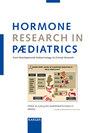Congenital Hypothyroidism with thyroid in situ: a case report with NKX2-1 and DUOX2 hypomorphic variants.
IF 2.6
3区 医学
Q3 ENDOCRINOLOGY & METABOLISM
引用次数: 0
Abstract
INTRODUCTION NK2 homeobox 1 (NKX2-1) encodes a transcription factor NKX2-1 that is expressed in the thyroid gland, lung and brain. Dual oxidase 2 (DUOX2) encodes an enzyme which generates hydrogen peroxide and is involved in the thyroid hormone synthesis. Cases of congenital hypothyroidism (CH) with dyshormonogenesis showing two or more genetic variants are increasingly reported. We describe the first case of transient dyshormonogenesis who had experimentally-verified a loss of function NKX2-1 variant and DUOX2 variants. CASE PRESENTATION The proband was a 15-year-old female patient with CH who was diagnosed in the frame of newborn screening for CH. She had a mildly elevated serum TSH level (14.56 mU/L), a low free thyroxine level (0.87 ng/dL), and a high thyroglobulin (Tg) level (>800 ng/mL). Ultrasonography revealed goiter. She was followed clinically without levothyroxine treatment, and showed normal growth and development. She had slightly high Tg levels throughout the clinical course. Next-generation sequencing-based genetic analysis revealed that the patient was heterozygous for an NKX2-1 variant (p.Ile228Ser), a nonsense DUOX2 variant (p.[Lys530*;His678Arg]), and a functional DUOX2 polymorphism (p.His678Arg). NKX2-1 p.Ile228Ser showed about 50% reduced residual activity on the Tg-promoter. CONCLUSION A partial loss-of-function NKX2-1 variant with a monoallelic nonsense DUOX2 variant and a DUOX2 functional polymorphism can cause transient CH with high serum Tg levels.先天性甲状腺功能减退症伴原位甲状腺:一例NKX2-1和DUOX2低常变异的病例报告。
简介NK2同源框1(NKX2-1)编码一种转录因子NKX2-1,该因子在甲状腺、肺和大脑中表达。双氧化酶2(DUOX2)编码一种产生过氧化氢的酶,参与甲状腺激素的合成。先天性甲状腺功能减退症(CH)伴有两种或两种以上基因变异的激素生成障碍病例的报道越来越多。我们描述了第一例经实验证实存在功能缺失的NKX2-1变体和DUOX2变体的一过性甲状腺激素生成障碍病例。她的血清促甲状腺激素水平轻度升高(14.56 mU/L),游离甲状腺素水平低(0.87 ng/dL),甲状腺球蛋白(Tg)水平高(>800 ng/mL)。超声波检查显示她患有甲状腺肿。在没有接受左甲状腺素治疗的情况下,对她进行了临床随访,结果显示她的生长发育正常。在整个临床过程中,她的Tg水平一直略高。基于下一代测序的基因分析表明,该患者是NKX2-1变体(p.Ile228Ser)、无义DUOX2变体(p.[Lys530*;His678Arg])和功能性DUOX2多态性(p.His678Arg)的杂合子。NKX2-1 p.Ile228Ser在Tg启动子上的残余活性降低了约50%。结论部分功能缺失的NKX2-1变体与单倍无义DUOX2变体和DUOX2功能性多态性可导致血清Tg水平较高的一过性CH。
本文章由计算机程序翻译,如有差异,请以英文原文为准。
求助全文
约1分钟内获得全文
求助全文
来源期刊

Hormone Research in Paediatrics
ENDOCRINOLOGY & METABOLISM-PEDIATRICS
CiteScore
4.90
自引率
6.20%
发文量
88
审稿时长
4-8 weeks
期刊介绍:
The mission of ''Hormone Research in Paediatrics'' is to improve the care of children with endocrine disorders by promoting basic and clinical knowledge. The journal facilitates the dissemination of information through original papers, mini reviews, clinical guidelines and papers on novel insights from clinical practice. Periodic editorials from outstanding paediatric endocrinologists address the main published novelties by critically reviewing the major strengths and weaknesses of the studies.
 求助内容:
求助内容: 应助结果提醒方式:
应助结果提醒方式:


